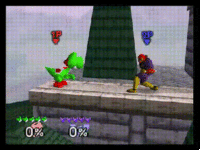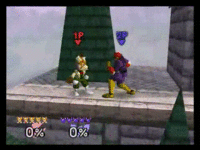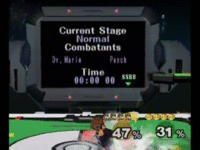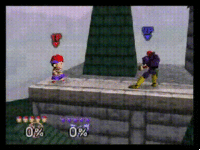Shield break combo



A shield break combo is a combination of attacks that enables a character to break an opponent's shield without the opponent having to hold down shield for the duration of the combo (also known as a "blockstring" in traditional fighting games).
Technical details
Normally, when one is shielding and then lets go of the shield button, the shield disappears. This does not happen when the shield is under attack. If one lets go of shield while the opponent's attacks are making contact with the shield, the shield will stay until the attacks stop for a certain amount of time (this is called shieldstun). As the attacks make contact, the shield gradually shrinks. If the shield size decreases too much, the shield will break, causing the shielding opponent to become stunned in place for a few seconds, depending on the damage.
How a shield break combo works is that the player performs attacks on an opponents shield which have low enough ending lag to allow the attacker to act before the opponent's shieldstun is over. If the attacker can act the same frame that the opponent can drop shield or perform an out of shield option, the attack is neutral (or +/-0 frames) on shield. If the shielding opponent can act before the attacker, the move grants frame disadvantage (or - frames) on shield; which is the case for most attacks. However, if the attacker can act before the shielding opponent, the move will grant frame advantage (or + frames) on shield. True shield break combos consist of players using moves which grant + frames on shield and then they use another attack which comes out before the shielding opponent can do anything. This next attack will either also grant enough + frames to do another attack or it will simply break the shield. This process is then repeated until the shield breaks.
This concept is not exclusive to the Super Smash Bros. series as it also applies to any other traditional fighting game or even any game where a player or an opponent can block or put up a shield (although it is much less important to know exact frames in games outside of fighting games).
An example of a shield break combo and how it works can be seen with Kirby's up tilt chain in Smash 64. Kirby's up tilt comes out on frame 4, has an FAF of 18 and grants 26 frames of shieldstun (assuming that the up tilt is fresh); which means that the opponent cannot act after shielding Kirby's up tilt until frame 31. This means that up tilt grants Kirby with a +13 frame advantage, giving him 13 frames to hit his opponent's shield before they can do anything. Because up tilt comes out on frame 4 and it has rather outstanding range, this gives Kirby more than enough time to perform another up tilt which will hit the shielding opponent before they can drop the shield. After performing three up tilts, Kirby can then use forward smash; which comes out on frame 10 (which is fast enough to hit the opponent before they can drop shield) and covers a lot of horizontal distance. Altogether, the three up tilts and forward smash deal 60 HP to the opponents shield (14 for each up tilt and 18 for the forward smash). As shields have 55 HP in Smash 64, this is enough to break the shield.
True shield break combos are only really common in Smash 64 due to shieldstun being very high; allowing numerous attacks (especially aerials along with Z-cancelling) to grant a frame advantage against shield. Shieldstun was significantly reduced in Melee which along with the weakening of L-cancelling and the 0.7x damage decrease to shields, significantly hindered the shield pressuring potential of many moves. Because of this, many moves became unsafe on shield and very few attacks outside of projectiles and items are + on shield. While shields, shield damage and shieldstun continued to be adjusted in each subsequent entry, shieldstun still remained low enough for most attacks to leave players at a frame disadvantage against shield. Because of this, the only true shield break combos in later entries (outside of moves which shatter shields in one hit) involve using projectiles and items to constantly hit the shield and lead into a powerful attack.
Examples of true shield break combos
(Most of these examples only apply to Smash 64 unless stated otherwise)
- Ness's double jump cancelled down aerial chain, known as the shield break jump.
- Kirby's down aerial into up tilt chain into forward smash.
- Yoshi's double jump cancelled neutral aerial chain into down smash.
- Fox's Shine cancel chain (this is a true shield break combo in Smash 64. It is not guaranteed in Melee however, the opponent only has two frames to act if Fox perfectly performs shines, making it very difficult and risky to escape.)
- Mr. Game & Watch in Ultimate can trap opponents with forward aerial and follow up with a full Oil Panic for a shield break.
Variants, special situations
There exist combos that are not always called "true shield break combos," but nevertheless can be utilized to break shields. These combos work only under certain situations. The two most common ones are the shield not being at full strength at the start of the combo and the shielder somehow being locked in a fixed position during the combo due to a feature of the stage. These are types of shield break combos which work in games after Smash 64.
Examples
- Falco's Shine cancel chain (Melee only)
- Peach's down smash (Melee only)
- A low-cooldown attack into a multi-hit attack is often considered a shield break combo
- Link's aerial bomb into neutral aerial into down smash in Smash 4
- A Pac-Man Bonus Fruit combo consisting of tossing a key against a shielding opponent, dropping a Fire Hydrant, then doing either a back aerial or neutral aerial to completely deplete a shield.
- Kirby's back aerial to forward tilt into forward smash in Ultimate. This is not true, and the back aerial must be done from a full hop, but it is especially effective when the opponent is shielding on a platform.
- Kirby's Hammer Flip in the same game can be used in the same situation, since an aerial Hammer Flip will hit shields twice as long as it is not fully charged. This "combo" is true and will instantly break a full shield, but will only work if the opponent is on a platform and if the Hammer is slightly charged.
